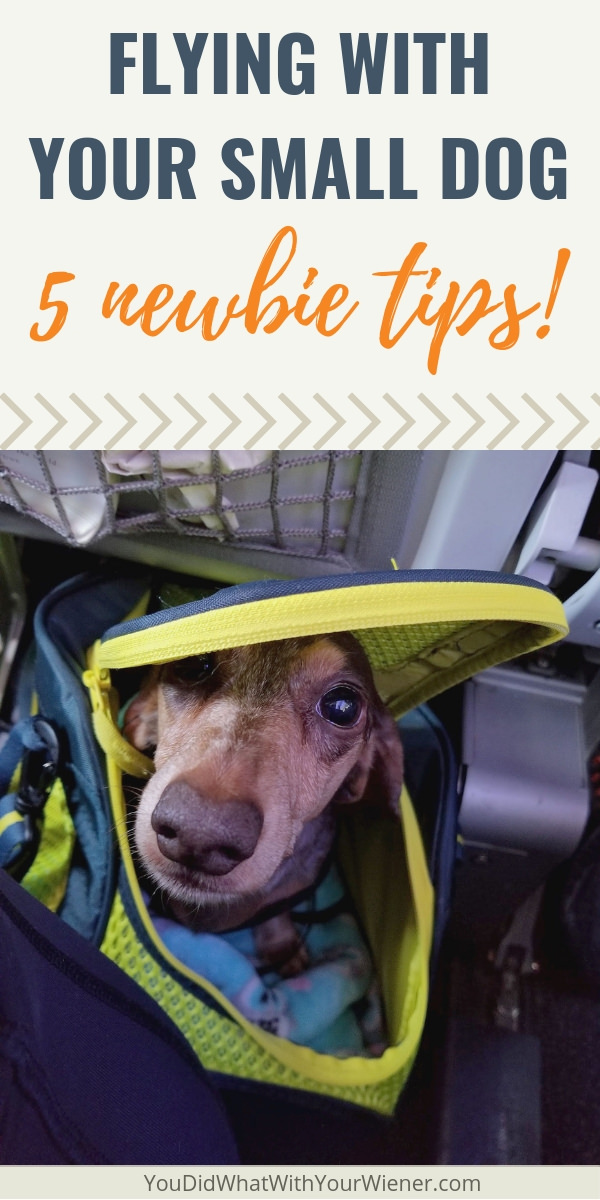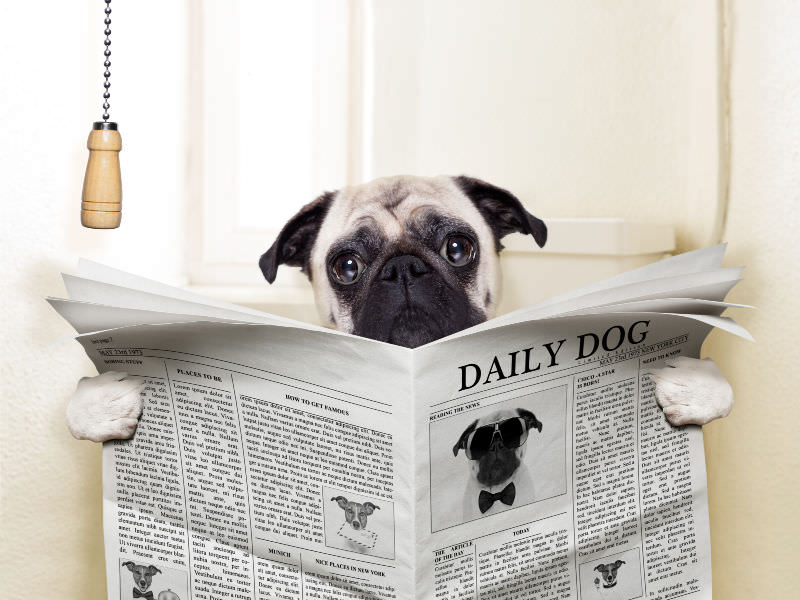9 Tips for Flying with Your Small Dog for the First Time
The thought of flying with your small dog for the first time may send shivers down your spine.
No doubt you’ve heard more than a few terrifying tales of fellow dog owners who’ve had disastrous experiences taking their pups along with them.
Whether you are moving overseas, or are fortunate enough to take your pooch along with you on vacation, the process may seem intimidating.
However, there are a number of tricks you can employ to minimize both you and your dog’s stress on the journey that awaits, and to have a fantastic trip overall.
Below, I share some things I learned, or wish I knew, the first time I flew with my small dog for the first time.
I also include some great tips from friends who have flown with their small dog.
UPDATED: May 17, 2023

5 First-Timer Tips for Flying with Your Small Dog
Be sure to also read my article 9 Lessons Learned After Flying with My Dog for the First Time
Note: some of the links below are affiliate links, which means that we receive a small commission on qualifying purchases if you buy something.
1) Be Prepared for Your Flight to Cost More
While your airline ticket will be the regular going price, you will need to pay at additional fee for your dog to fly with you.
Yes, you will have to pay this additional fee even though your dog will go under the seat where your free carry on personal items would go.
So, how much is a plane ticket for your small dog?
The fee can vary by airline but the typical fee is $100-$150 each way.
That means that you’ll need to budget up to $300 if you plan bring your dog with you on the airplane.
Note: there is no additional charge for service dogs but emotional support dogs (ESA’s) are now considered normal pets on most airlines so a fee is required.
2) Make Sure Your Dog Can Actually Fly In-Cabin With You
Well before your flight, you need to read up on what your chosen airline’s policy says about traveling with pets.
Some airlines require a reservation for your pet.
Also, airlines will have a weight and size restriction for dogs flying in cabin.
The general rule is that if your dog can comfortably and safely fit in a carrier that is the correct dimensions to fit under a seat, your dog will be allowed to fly in the cabin with you.
Specifically, the weight limit for dogs flying in cabin is 20-25 lbs for most airlines.
However, there are a few key points to be aware of.
First, the definition of comfortably and safely is up to the discursion of the flight attendant checking you in.
At the very least, your dog needs to be able to turn around inside the carrier but some attendants concerned for animal welfare may personally choose for there to be even more space.
For example, they may like to see that your dog’s body only takes up half of the carrier space.
Here are some tips from friends about making a reservation for your dog to fly with you and the size that will be allowed in the cabin.
“… when booking over the phone, it’s common for the call center staff member to ask the weight of your pet plus carrier combined, plus the dimensions of the carrier, to ensure it meets their guidelines. So make sure you have this handy.” – Shandos, Travelnuity Blog.
“Know the length of your dog and the airline rules.
For example, my corgi, Eve, is under the weight limit for most airlines (she is 23 lbs and they tend to say 25) BUT, she is too long to fit perfectly in the under-seat carrier and might not be able to stand and turn around as is required by Southwest (but not necessarily required by other airlines). [it’s] risky to try if the rules might be against you.
So know your dog’s weight but also length and ability to stand up in the carrier. And know the airline’s under seat height. I won’t risk trying to take her on Southwest, but American, which has higher under-seat area and less concern with the ability to stand and turn.” – Carleen, Some Pets Blog.
If you arrive at the gate to check in and the flight attendant deems your dog to be too big for the carrier, or to fly in the cabin, you may be denied for the flight or your dog may have to fly in the cargo area away from you.
3) Your Dog Will Need to Remain in the Carrier for the duration of the flight
You may be wondering if you can fly with a small dog on your lap.
Unfortunately, with the exception of service dogs, your dog will need to stay in their carrier for the whole flight.
Many airlines explicitly state this meals on the floor with all sides of the carrier zipped close.
In my experience, no one said anything if I unzipped part of the carrier so I could stick my hand inside to comfort my dog during the flight.
But it was a challenge to keep my dog in there because she wanted to poke her body or head out of the hole as soon as I opened it.
It used to be that ESAs (Emotional Support Animals) were allowed to sit on your lap during a flight but that is no longer the case.
4) Prepare for the Flight in Advance
Secure a Spot for Your Small Dog on the Plane
While not all airlines allow reservations – some are first-come-first-served – calling your airline ahead of time can help.
Sometimes they can give you an idea of how early you should arrive and maybe how many other people-with-pets have called ahead.
Consider Checking With Your Vet
All airlines will require that your dog is up-to-date on shots (bringing a signed vaccination record from your vet is always a good precaution but not always mandatory when flying with your dog inside the cabin).
In addition, you may also be required to supply a notice from your vet indicating that your dog is fit to travel and exhibits no chronic medical conditions which may prevent it from flying.
Get the Right Carrier
Airlines require you to bring your pup in a carrier, which has to fit beneath the seat in front of you.
You can usually check online, or call ahead, to see what the dimensions of the carrier need to be for the particular plane you will be riding in.
My favorite for flying with my dog is the Sleppypod Air.

Remember that the aisle seat can have a smaller under-seat space than the middle and window seats.
If you have the funds and have ever considered trying out that business class upgrade, this might be the time, which would give you and your dog some extra space and legroom.
Have a Pee Plan
Know where the nearest potty station is at your airport. Some have designated potty stations outside and/or inside the terminal.
You’ll want to know what side of security it’s on and plan accordingly for a potty break before your board your plane.
You may want to consider lining your dog’s carrier with a pee pad or two in case they have an accident.
I also know some people who bring a pee pad to lay down on the restroom floor for their dog to go if needed (their dog is trained to go on potty pads).
5) Pack Appropriately for Your Dog
Consider your pets needs and ensure a separate pocket is allocated for them in your carry-on.
This is where any medication, snacks, and a non-spill water container for them should be kept.
Include familiar items, such as their favorite toys or a soft blanket. These possessions will allow your pup to feel a lot more at home and at ease during the potentially scary experience of flying.
Some things on my must-bring list include:
Here are some tips from my friends who regularly fly with their dogs nationally, and internationally:
“Whether you’re traveling overnight, for a week, or for a month, always bring some dog food with you in your carry on.
Here are a few reasons why:
- If your plane is delayed and dinnertime rolls around, you’ll be prepared (but don’t fly on a full belly!).
- If you’re planning to buy dog food at your destination, having some on hand will give you extra time to purchase it in case of any unforeseen obstacles (the store is closed, they don’t have your food in stock, etc).
- If your checked bag with food in it is lost or delayed by the airline, you’ll have back up in your carry on.”
Candy, Boogie the Pug Blog.
“Pack extra for the flight. Flights get delayed and cancelled all the time. Don’t be caught short while travelling.
We always pack extra collars and leads, pee pads and food (just in case). There is nothing worse than having a lead break or collar get lost when you are in a foreign area and don’t know where the nearest pet shop is (or can’t leave the airport!).
We don’t recommend changing your dogs regular food while on a trip so if you aren’t sure if you can get it while on vacay, make sure you bring it with you (and pack extra to allow for delays).” – Kimberly, City Dog Expert Blog.
6) Getting Through Airport Security

One of my biggest surprises when I brought my dog through the airport security line was being pulled aside to have my hands swabbed for explosives.
Just know it will happen and it’s no biggie.
“When you go through security with your dog, you will need to hold them in your arms as you go through the metal detector. The carrier will go through the x-ray machine with your other carry-on luggage.
After you step through the metal detector, a TSA employee will swab your hands. This test is to make sure you don’t have your dog carrying explosives for you.
I’ve never had a bad experience going through security. It’s always been easy, and I’ve even been escorted to the front of the line (perhaps because I have a cute dog?”
I also make sure to have Wynston’s vet records on hand just in case they ever ask for it. Better to be safe and prepared.” – Amanda, Dog Mom Days Blog.
“… I got swabbed again at the Kansas City airport on the way home.
I did some more digging online and read that people traveling with pets usually get swabbed for explosive residue because criminals have been known to hide explosives inside pets. Disgusting, I know.
Regardless, don’t be surprised if you get flagged for a hand swab when flying with your [pet]!” – Emily O.H.
7) Be Well Prepared Before You Board the Plane
If you have access to a dog potty area in the airport, give your dog an opportunity to use it.
Not only will your dog have to wait to potty until you get off the plane again, it may have been an hour or more prior to boarding the plane that they last relieved themselves.
While my 10-lb Dachshund Gretel held it for a 6 hour flight once, not all dogs are able to do that.
It’s best to try and prepare your dog to sleep on the plane. If your dog sleeps through the entire flight, it’s less stressful on both of you.
Some good ways to help make that happen are to:
- Take your pet for a long walk before you get to the airport
- Take them to the pet potty area and walk them around the vicinity a bit
- Try and keep them entertained and awake while you are waiting to board your flight
Otherwise, giving them something that can relax then and potentially make them sleepy, like VetriScience Composure Pro, Benadryl (always check with your vet first!) or CBD dog treats, is an option.
Also before boarding, make sure you have your pet-fee receipt easy accessible in case the gate attendant asks for it.
8) Ensure a Good Experience During the Flight
Be aware that your dog in a carrier counts as either your carry on bag or personal item (purse) so you can only bring one bag in addition to your dog.

Since your dog is going under the seat, you will have to place the other bag in the overhead bin.
That means that all of your stuff will be up there too.
While you can get up mid flight and get one or two things out of your bag, it’s a hassle if not impossible.
It’s a good idea to slip a few small things into the seat pocket in front of you or in the pocket of your dog’s carrier if it has one.
During the flight, it’s important for you to stay calm. Yes, you.
When you are nervous or anxious, your dog can sense it and they are more likely to be restless and upset.
Personally, I’ve found it best to check on my dog as little as possible during the flight.
Of course, you’ll want to make sure they are safe but I often make the mistake of checking on her again and again and not giving her time to sleep or settle.
The chance is good that if she needs attention, she will make it known.
With that being said, your dog may need a little reassurance, at least the first few times on a flight.
While being mindful of not disturbing them too much, it can be helpful to talk to them quietly and calmly (even if you sound a little bit crazy to fellow travelers).
It can also help to occasionally stick your hand in their crate to reassure them if they seem fussy.
You know your pup best, so try and read the situation and do what you think is necessary in the moment.
9) Potty Your Dog Immediately After Getting Off the Airplane

Your first mission once you get off the plane is to reach a potty station as soon as possible so your dog can stretch their legs and relieve themselves.
It’s best to research available pet relief areas at your destination airport, or any layover airports, before your flight.
In some cases, you may have to take a detour inside or outside of the airport to the pet relief area before you head to baggage claim.
If your flight is a layover and the nearest potty station is outside of security, beware that you will need to allow time to go back through the security line before boarding your connecting flight.
This is one time that there is a definite advantage for dogs that are trained to go on potty pads as you can place one on the floor in the nearest bathroom and let your dog do their business.
Final Thoughts
If you fly with your small dog, be mindful that your dog may be restless and a bit agitated after the flight because they have been stressed or sleeping for a long period.
When you get to your final destination, thank your dog for being patient and handling the situation so well by taking them for a walk or playing fetch.
Overall, the whole process of flying with your beloved dog may feel intimidating.
However, these tips should have at least given you a little peace of mind on the topic.
And once you have flown with your dog on an airplane a couple times, you’ll feel like a pro!
Enjoy your travels, and bon voyage!

About the Author
Hi, I’m Jessica. I’ve been studying the Dachshund breed since 2007, owned 3 of my own, and shared in the lives of thousands of others through their owner’s stories. When I’m not sharing what I know on this blog, you can find me hiking, camping, and traveling with my adventurous wiener dogs.

is there a way to bring my dog who barks at everybody, and every dog he sees on a plane? Thanks.
Drugs. I’m not joking. That’s probably only the only thing that will work if your dog really barks at everything all of the time. Trazadone can work wonders and you can get it from your vet. Airlines recommend against sedatives now though so discuss this with your vet. Personally, I would only resort to this if there was a reason my dog HAD to fly with me. Like moving or something. If it was just for fun, I would leave my dog at home or drive. Good luck!
Hi: Is it safe to travel with my 2 month dashund?
Flying I assume? Yes. My breeder flew my 8 month old puppy to me in a carrier underneath her airline seat. It’s likely your pup has not had all her shots at that age though so should remain in the carrier as not to be exposed to germs.
I know this is an older post, but just in case, what about flying with 2 dogs/1 person? I’ll be moving with 2 tiny dogs. I know airlines are often one day per passenger, but if I am willing to buy an extra seat, do you know if they would allow two dogs?
Hi Aslan. It can vary by airline. If your dogs are small enough (say, 5 lbs each), you may be able to bring them in one carrier. My friend flew with two puppies in the same crate to deliver them to their new owners. Some airlines will allow you to pay for a second seat in order to travel with two but many will not.